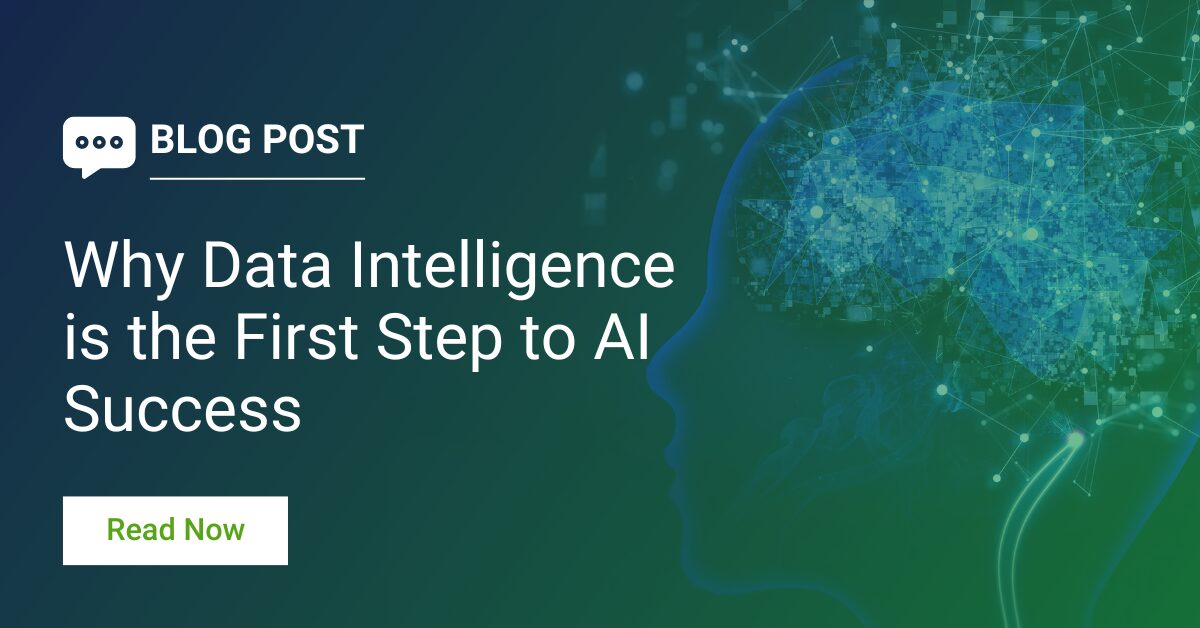Why Data Intelligence is the First Step to AI Success
Russ Kennedy shares insights from Gartner’s recent Infrastructure, Operations & Cloud Strategies (IOCS) conference around AI and data intelligence.
February 14, 2024 | Russ Kennedy

You can’t listen to a podcast, scroll through the news, or watch a game without being bombarded by AI-themed advertisements. Infrastructure vendors are AI-washing their technologies to bolster their appeal and relevance, as if merely attaching that shorthand suddenly improves their offerings. Back in December, when I attended Gartner’s Infrastructure, Operations & Cloud Strategies (IOCS) conference, one of the consistent themes was that Generative AI (GenAI) and data intelligence are at the peak of the hype cycle.
Today, enterprises are experimenting with AI solutions in the form of sales and support chatbots developed by trusted vendors. But there is more to this new wave of technology than intelligent chat interfaces. So how do you put yourself and your organization in a position to capitalize on the AI solutions that will prove truly transformative?
I’ve shared a few related tips and insights in Forbes, including my articles “How to Evaluate Generative AI for the Enterprise” and “Five Questions to Consider When Evaluating an AI Solution.” These pieces are a good place to start, but here at Nasuni we have been designing and building the technical tools, systems, and methodologies necessary for enterprises looking to effectively deploy AI.
The Necessity of Data Intelligence
One of the primary reasons large language models are so powerful is that they were trained on trillions of words. They had access to high-quality datasets. As a recent Salesforce commercial suggested, if AI is the wild west, then data is the new gold.
What does that mean for the enterprise? You have to start by understanding what data you have and where this data is located. Before you can make use of artificial intelligence, you need data intelligence. Nasuni is in a very unique position to help in this regard. The Nasuni File Data Platform functions as the single global namespace for your enterprise data, consolidating all that “scattered gold” in one place, no matter the scale. So, we decided our first major foray into the AI space would be a very practical and necessary service and essential first step for large organizations.
Next week, Nasuni will be announcing the ability to provide unprecedented visibility into file system operations in your Nasuni environment, enabling a new level of business planning capability to ensure this environment meets your goals, and allowing for easy-to-consume analytics on your full file system operations. This is only the beginning. It will be the first step in a multi-phase data intelligence strategy, and it will be a critical tool for our customers as they prepare to leverage AI in new and unexpected ways.
The 4 Stages of AI Readiness
Although AI is undeniably transformative, we don’t know how it will evolve in the next few years. What we do know is that these tools will only be as good as the data they consume. You are going to need the right data in the right systems. Generally, getting your organization ready for AI will consist of four stages.
- Assess Silos: Most organizations suffer from data sprawl. This exploded during the pandemic, as more departments and end users stored their files in more systems. As an enterprise, you need to assess what data you have and where it is stored before you can hope to put AI to work.
- Consolidate: Next you need to consolidate that data through a platform that has proven security and offers unlimited scalability – likely a cloud service from one or more of the hyperscalers. For obvious reasons we have been making this cloud scale and consolidation argument for years. This is our business, and global data consolidation of the sort that Nasuni provides is only going to become more important in the age of AI. You will not be able to get the most out of these advanced tools if your data is distributed across hundreds or thousands of disparate silos.
- Secure: The platform you select and the data you expose to your chosen AI tools must be secure against unwanted exposure or malicious vectors of attack. Taking another pass at securing your data is essential before you begin using AI.
- Curate: Finally, you must ensure that you are leveraging the right data for AI. This data needs to be current and relevant. You don’t want duplicative data included, and you need to be certain the data you do include will not lead the AI model to return inaccurate information.
Your AI Strategy & the Fit for AI Value Pyramid
In a broader sense, you are going to need a comprehensive data and AI strategy. To help our customers in these efforts, we’ve been developing our Fit for AI Value Pyramid to guide you through the four phases, ensure that you get the most out of your usage of AI, and steer you toward a successful AI transition.
Today, I’d suggest leveraging the AI tools that are available to you for sales and support. When it comes to exposing new tools to your corporate file data, however, you are going to need to build your data intelligence and map out a full AI strategy. Nasuni’s Fit for AI Value Pyramid will be a valuable tool in your chest to help you get your data ready to realize the benefits of AI. The reality is that none of us can predict exactly how these tools will change enterprise IT and operations. But AI-driven change is coming, and enterprise IT leaders need to ensure their organizations are ready to capitalize when the next wave of proven, transformative tools emerge. You can count on Nasuni to be your partner in that journey. Data is gold, and Nasuni will help you get your enterprise data ready to mine that latent intelligence and deliver on the promise of AI.